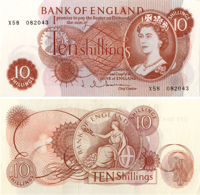020 7636 1188 info [at] coincraft.com
You have no items in your shopping cart.
Jasper Hollom (1962-1966)
View as
Sort by
Display per page
J Q Hollom Portrait £1 B290 Replacement AUnc
Crisp AUncirculated examples of the Hollom Replacement Portrait £1 with the catalogue reference B290. All replacement notes are scarce because they were issued in much smaller numbers. Their purpose was, as their name implies, to replace notes damaged in production. They were given a special prefix to identify them. In the case of the Portrait series, this included the letter M. Our Hollom Replacement Portrait £1 notes have the prefix –M. They are AUncirculated. Limited availability
£45.00
J Q Hollom Portrait £5 B297 EF/GEF
J Q Hollom £5 Blue Portrait B297 Queen Eliz/ Young Britannia EF/GEF
£45.00
J Q Hollom Portrait £5 B297 Fine
In 1963, the Bank of England unveiled a new £5 note. It was an historic issue because it was the first time the Bank had issued a £5 note with a portrait of the reigning monarch (B297) With the signature of J Q Hollom, a portrait by Reynolds Stone of the young Queen Elizabeth II appears on the front. She is shown wearing the George VI diadem and her trademark three strand pearl necklace. The figure of a child Britannia is on the back. We offer this historic note in several grades, Fine, Very Fine, Extremely Fine and Uncirculated.
£17.50
J Q Hollom Portrait £5 B297 Unc
J Q Hollom £5 Blue Portrait Queen Eliz II/ Young Britannia Unc. The first Portrait £5 notes were issued when J Q Hollom was Chief Cashier(B297) This was the first Bank of England £5 note to feature a portrait of the reigning monarch. First issued in 1963 a youthful portrait of Queen Elizabeth is on the front and a rendition of a Young Britannia, based on the artist Reynolds Stone’s daughter, is on the back. Here we offer Choice Crisp examples in Uncirculated.
£70.00
J Q Hollom Portrait 10/- B294 EF/EF+
J Q Hollom 10/- Red Brown Portrait B294 Queen Eliz/ Young Britannia Crisp EF.
£8.75































